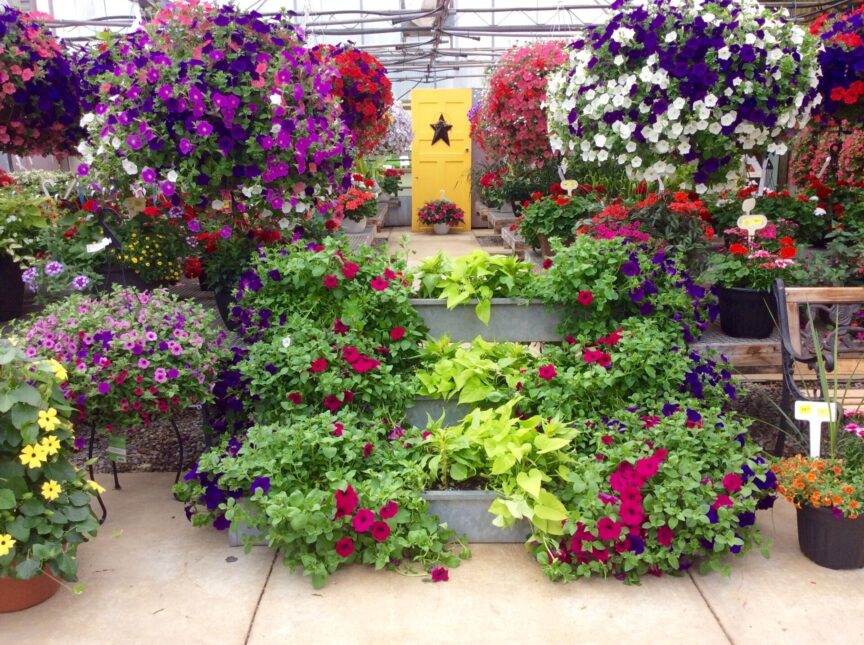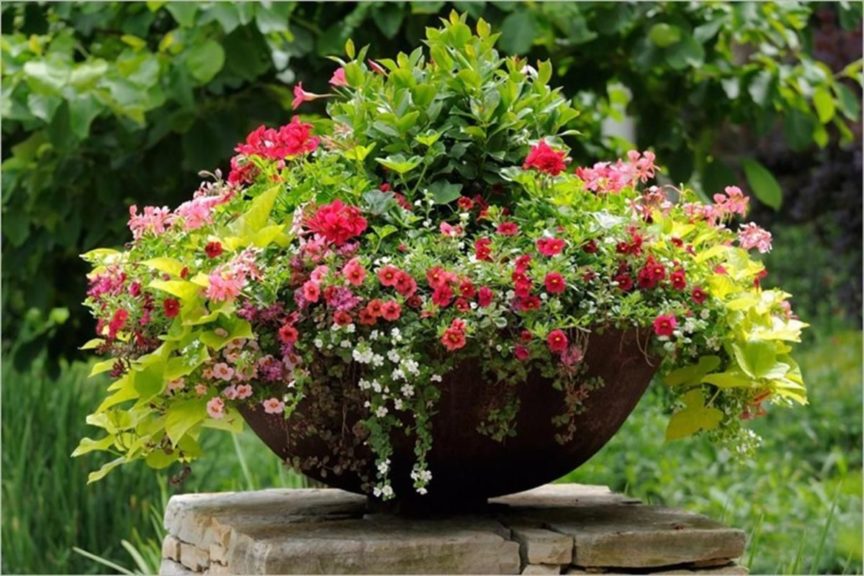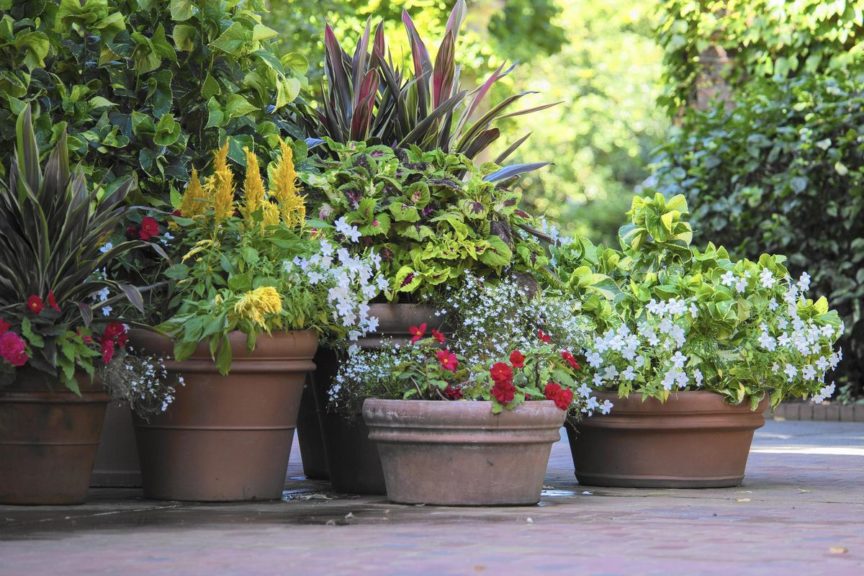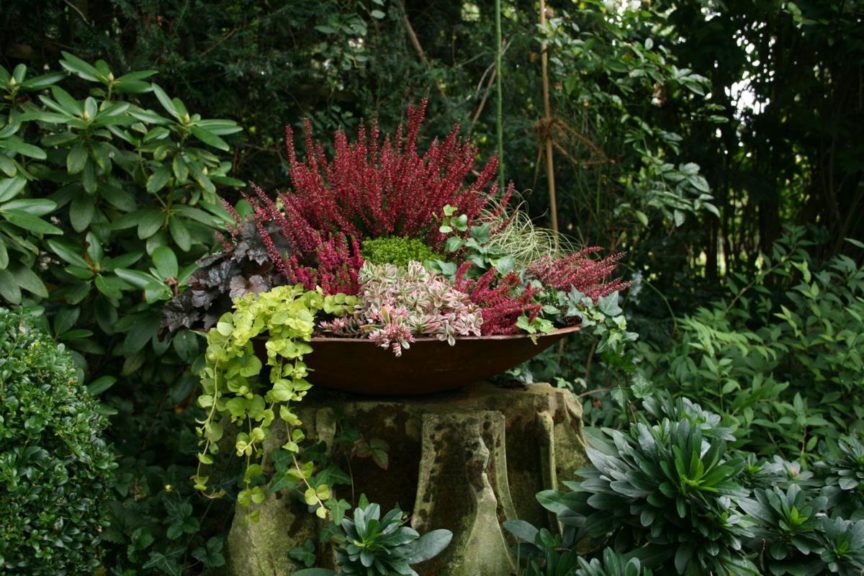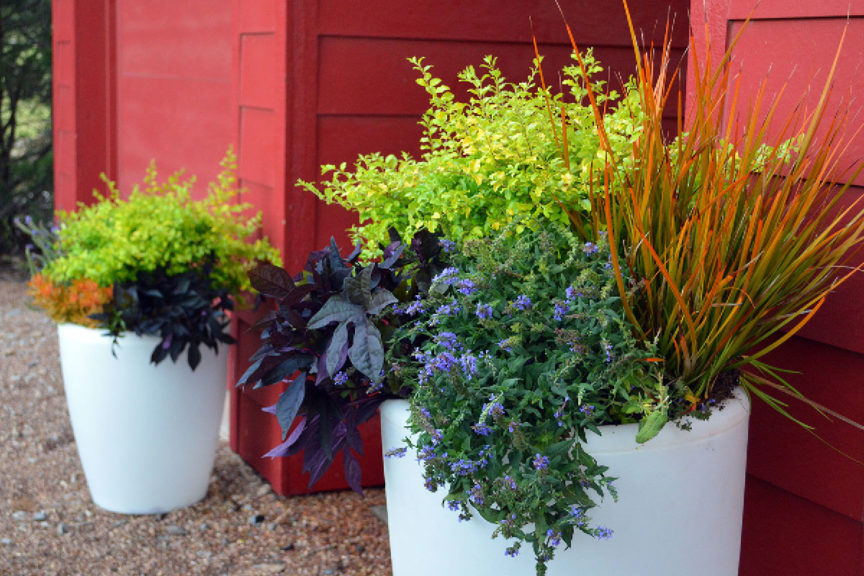Pots overflowing with colorful flowers and lush foliage improve any deck, patio or balcony. Container gardening allows anyone to enjoy the pleasure of growing plants. In the sun, try a fragrant pot of lavender that honey bees will love. In the shade, beautiful hostas and begonias will thrive.
The secret to creating a professional looking container with full mature plants is to leave no open spaces – if you are using young transplants though, give them room to grow and thrive. When planting annual flowers in the ground generous spacing allows the plants to grow bigger.
Container gardening also adds versatility to gardens large and small. Plants lend instant color, provide a focal point in the garden, or tie in the architecture of the house. A pair of matching containers on either side of the front walk serves as a welcoming decoration, while containers on a deck or patio can add color and ambiance to outdoor sitting areas.
Containers planted with a single species such as a bold variegated ornamental grass, can be stunning garden accents. Containers planted with a mix of plants are fun to create and offer almost unlimited possibilities of combinations. The best combinations depend on plants that feature handsome foliage and flowers that will produce blooms over a long season.
One easy guideline for choosing the plants to combine in a container is to include “a Thriller, a Spiller, and a Filler.” That translates to at least one plant that will be the focal-point (the thriller), such as an upright coleus or a geranium, combined with several plants that spill over the edge of the pots — such as petunias, licorice, or potato vine. Finally, add the fillers, which are plants with smaller leaves and flowers that add color and fill in the arrangement all season long. Good fillers include salvias, impatiens, and wax begonias. You may also want to include a plant for a bit of added height in the background, such as purple fountain grass. Add a small trellis to a container and you can use a vine (dipladenia) to also add height to the composition. You’ll need a total of five or six plants for a 16 to 21 inch container.
When you are choosing plants for your container make sure that they will play well together. This means that all the plants in one pot should all require the same amount of light and moisture. If you combine plants with different needs, some of them will not thrive as well as they could or should.
Keep in mind that it’s easier to grow plants in large containers than small ones. That’s because large containers hold more soil, which stays moist longer and resists rapid temperature changes. Small hanging baskets are especially prone to drying out, and during hot summer weather, you may need to water them twice a day to keep the plants alive.
Whatever sized container you choose, drainage holes are essential. Without drainage, soil will become waterlogged and plants may die. The holes do not need to be large, but there must be a few that excess water can drain out. If a container has no holes, try drilling some in the bottom of the pot yourself.
Plastic and fiberglass pots and planters are lightweight, relatively inexpensive, and available in many sizes and shapes. Choose sturdy and somewhat flexible containers. Since some larger containers are heavy once they’re filled with soil, decide where they will be located and move them into position before filling and planting. Don’t fill pots to the top with your soil mixture — leave space for watering. If keeping them watered during the day is a problem, look for placing them in areas that receive morning sun but get shade during the hottest part of the day – even if you’re growing plants for full sun. Afternoon shade will help reduce the daily amount of moisture that the plants may need.
Almost any vegetable, flower, herb, shrub, or small tree can grow successfully in a container. Use your imagination and combine upright and trailing plants, edibles, and flowers for pleasing and colorful effects. For containers that remain attractive all summer long, look for warm-weather annuals that bloom all through the season or have foliage that remains bright and attractive. Some deadheading of certain plants can help extend their flowering period.
Water your container plants thoroughly. How often depends on many factors such as weather, plant size, and pot size. Don’t let the soil in containers dry out completely, as it is hard to re-wet. Don’t forget that wind plays an important factor in drying out containers even when the sun isn’t at its hottest.
Container gardening plants need regular fertilizer feeding. Start by feeding once every two weeks; and adjust the frequency depending on how the plant responds. The bigger the plant grows the more nutrition it may need. Your local garden center will have just the right fertilizer for your needs. 🙂
Since containers can be focal points in the garden, you will probably want to give them special attention to keep them looking their best. Remove tattered leaves and deadhead spent flowers. Prune back plants that get leggy or stop blooming. Most of all, enjoy the beautiful containers that you have created.
Ideas of Thrillers, Fillers and Spillers: https://youtu.be/xyaSNOTqQEc

